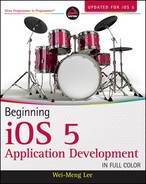11
Database Storage Using SQLite
WHAT YOU WILL LEARN IN THIS CHAPTER
- How to use the SQLite3 database in your Xcode project
- Creating and opening a SQLite3 database
- How to use the various SQLite3 functions to execute SQL strings
- How to use bind variables to insert values into a SQL string
- Bundling a pre-built SQLite database with your application
As you continue on your iOS development journey, you will soon realize that your application needs a way to save data. For example, you may want to save the text that the user is entering into a text field, or, in an RSS application, the last item that the user has read.
For simple applications, you can write the data you want to persist to a text file. For more structured data, you can use a property list. For large and complex data, it is more efficient to store it using a database. The iOS comes with the SQLite3 database library, which you can use to store your data. With your data stored in a database, your application can populate a Table view or store a large amount of data in a structured manner.
![]() NOTE Besides using SQLite for data storage, developers can also use another framework for storage: Core Data. Core Data is part of the Cocoa API, which was first introduced in the iPhone SDK 3.0. It is basically a framework for manipulating data without worrying about the details of storage and retrieval. A discussion of Core Data is beyond the scope of this book.
NOTE Besides using SQLite for data storage, developers can also use another framework for storage: Core Data. Core Data is part of the Cocoa API, which was first introduced in the iPhone SDK 3.0. It is basically a framework for manipulating data without worrying about the details of storage and retrieval. A discussion of Core Data is beyond the scope of this book.
This chapter shows you how to use the embedded SQLite3 database library in your applications.
